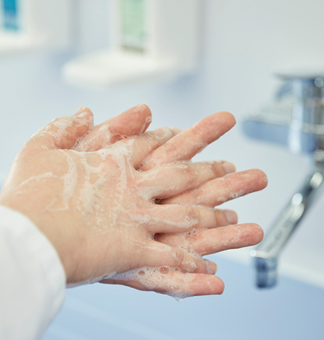Disinfectant or soap? Meta-analysis examines efficacy against community-transmitted respiratory infections

As gloves can rupture during operations, surgical staff must thoroughly clean and disinfect their hands before any procedure to reduce the risk of surgical site infections (SSI) in their patients. Both, alcohol-based and chlorhexidine-based hand disinfectants can be used for surgical hand disinfection as they meet disinfection requirements and reduce SSI [1]. In contrast to alcohol-based hand disinfectants, however, chlorhexidine has some disadvantages, especially when used regularly.
Chlorhexidine (CHX) is an antimicrobial agent that was developed in the 1940s and was introduced in the medical field in the 1950s. Its activity against Gram-negative and Gram-positive bacteria is based on its positive charge, which is attracted by the negative charge of the bacterial cell membrane [2, 3].

After binding, the surfactant CHX dissolves membrane lipids and leads to disruption of the cell membrane [3]. CHX is a non-volatile and remanent chemical that sticks to the skin by binding to keratinocytes from which it is slowly released over time [4].
Contact dermatitis is one of the most common allergic reactions to CHX and has been reported to occur in approximately every fifth healthcare worker with regular exposure [5, 6]. Beyond that, a wide variety of hypersensitivity reactions ranging from mild cutaneous reactions to anaphylaxis have been observed in perioperative and medical procedural settings [6]. However, anaphylaxis is rare and usually only occurs after a history of mild localized reactions to earlier exposure [6]. Although the mechanism of allergic sensitization to CHX is still unknown, it is assumed that skin barrier impairment may contribute. In addition, the risk of allergic sensitization appears to increase with higher CHX concentrations [6].
Another important aspect when using CHX is the risk of antimicrobial resistance or tolerance. A recent systematic review that summarized resistance development in important pathogens—among them Pseudomonas aeruginosa, Klebsiella pneumoniae and Acinetobacter baumannii—showed increases in the mean inhibitory concentration (MIC) over the last decades, suggesting that some microorganisms are becoming less susceptible to CHX [2]. As even the increased MICs are still relatively low when compared to the concentrations of CHX used for disinfection there is currently no risk, but cautious use of CHX is definitely advised, particularly to avoid the development of cross-resistance to clinically relevant antibiotics[2].
In current times, when periods of dry weather are becoming more frequent and water shortages are affecting even developed countries, resource conservation is also playing an increasingly important role in the selection of hygienic methods. While alcohol-based products are applied without the use of running water, it was shown that one surgical hand disinfection episode with traditional agents such as CHX used 18.5 liters of water on average [7]. Therefore, using alcoholic rub instead of scrub products could save almost 1 million liters of water annually in an average hospital, which should also be considered from a sustainability perspective [7].
Conclusion: CHX surely has its place in special situations, such as patient bathing before certain procedures, where it can effectively contribute to SSI reduction. However, optimized alcohol-only formulations do not require CHX for immediate and sustained efficacy [8]. Thus, for routine surgical hand disinfection, alcohol-based agents should be preferred.
Sources: